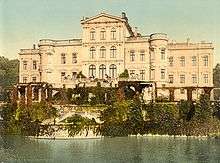House of Putbus

Pedebuz or Podebusk or Putbus was a highly noble, ultimately princely house in Pomerania and Rügen, territories in northern Europe on the south Baltic Sea coast.
History


The aristocratic family of Putbus is of Slavic origin and a collateral line of the Rügen princely house. It is descended from Stoislav, who was documented in 1193 and was probably a close relative of Prince Jaromar I - perhaps a brother. To begin with the lords of Putbus had the same territorial status as the Rügen princes, but later became their vassals. Their original possessions were near Vilmnitz (today in the borough of Putbus) on the island of Rügen and near Brandshagen. The name Putbus first appeared in 1286 and was adopted by all members of the family in the mid-14th century.
The family continued to hold lordship in some parts of Rügen, actually until the communist takeover after World War II.
In early modern epoch, lords of Pedebuz became recognized as barons.
In 1672, they were created counts of Holy Roman Empire and in Sweden.
In the 19th century, they were created princes (Fürsten).
When the original male line became extinct, the lordship and several of the titles were inherited by progeny of daughters (see Wilhelm Malte I: Progeny).
The Communists in East Germany confiscated the estate and destroyed the castle.
The present-day heir is Malte de Putbus.
Lineage of Podebusk
Stoizlav of Vilmnitz was one of earliest attested forefathers.
Head of the House
- Henning Podebusk (died 1388), last Drost of Denmark
..
- Moritz Ulrich I (1699–1769), President of the Wismarer Tribunal (see Swedish Wismar)
- Malte Friedrich (1725–1787), Government and High Court President in Swedish Pomerania
- Wilhelm Malte I (1783–1854), Governor of Swedish Pomerania
- Wilhelm Malte II (1833–1907), Steward and hereditary marshal in New Western Pomerania
- Malte von Putbus (1889–1945), landowner on Rugia Island
- Franz Wilhelm Dietrich Albrecht, Prince of Putbus (28 May 1927 – 5 April 2004)[1]
- Malte von Putbus, born in 1964, is now the chief of the family "Fürst zu Putbus"
- Xavier Louis von Putbus, born the 29/06/1962, married with Bettina von Putbus, the dautghter of the Prince and Princesse zu Putbus. He got the authorization to be called von Putbus from his Majesty Baudoin I, king of Belgium, via his Minister of Justice Melchior Wathelet the 15/01/1992.
References
External links
- medieval lords of Pedebuz and Vilmnitz, and their some agnates
- lineage from high-medieval lords of Pedebuz to early modern agnates
- agnates of Putbus in modern era